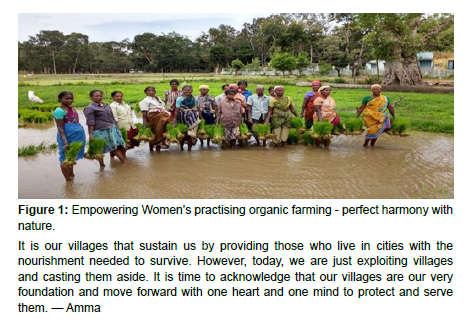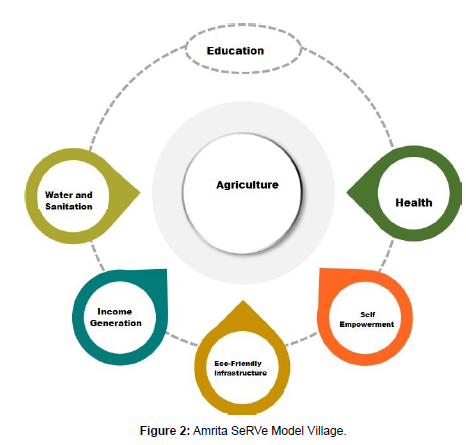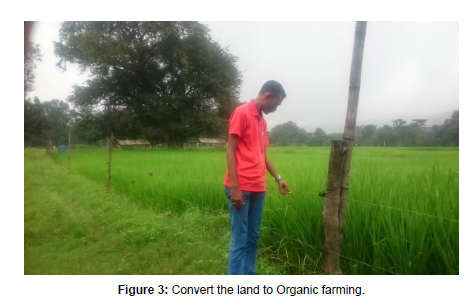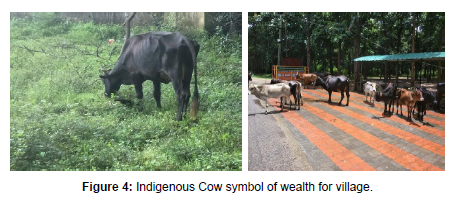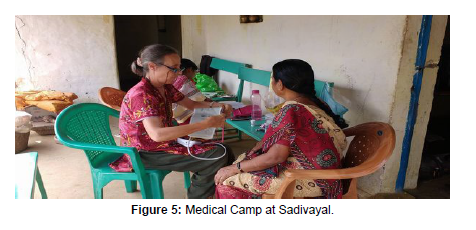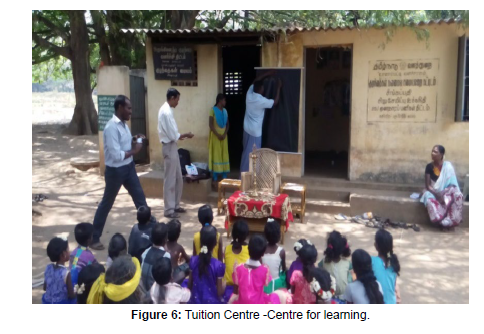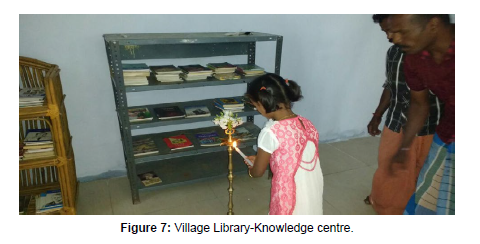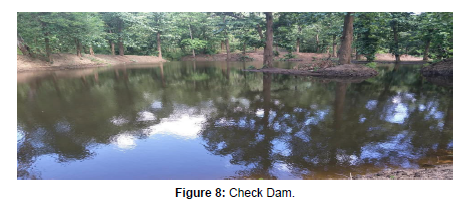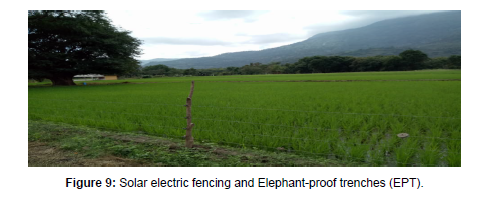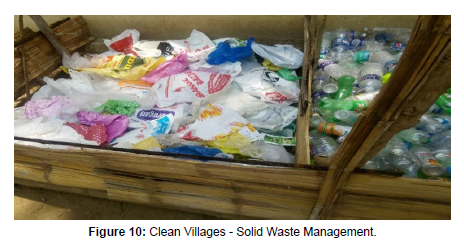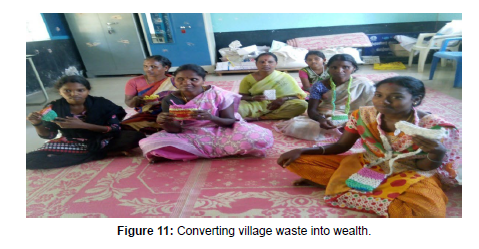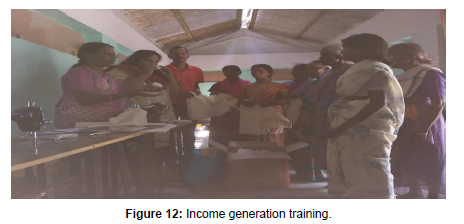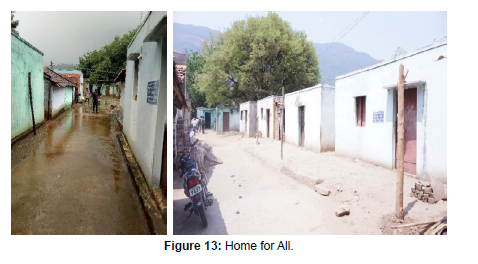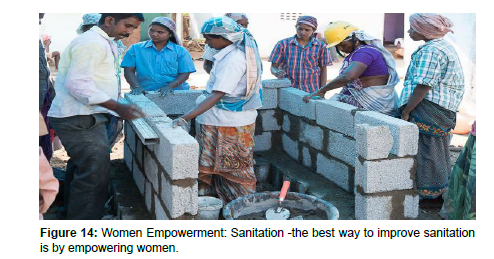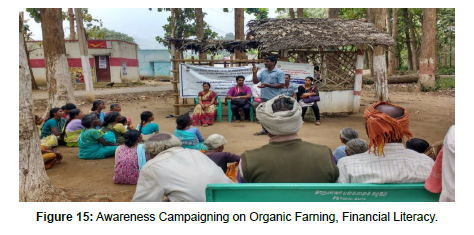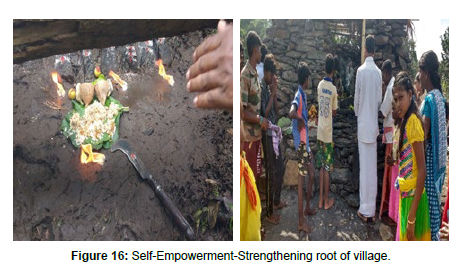"Smart Tribal Village" Where Communities Deploy Innovative and Creative Solutions to Increase their Resilience, Using Local Advantages and Capabilities
Received: 02-Oct-2023 / Manuscript No. acst-23-114844 / Editor assigned: 05-Nov-2023 / PreQC No. acst-23-114844 / Reviewed: 19-Nov-2023 / QC No. acst-23-114844 / Revised: 23-Nov-2023 / Manuscript No. acst-23-114844 / Published Date: 30-Nov-2023
Abstract
To develop the first Smart Village, Amrita Self Reliant Village (Amrita SeRVe) has adopted Sadivayal village in Coimbatore, one of the isolated tribal communities in Tamil Nadu. The village, located 45 kilometres from Coimbatore district and comprising 46 families with an average population of 150, is inhabited by the Irula community of Scheduled Tribes. The Amrita SeRVe Smart Village aims to improve access to food, nutrition, education, healthcare, clean water and sanitation while maximising available local resources. Agriculture serves as a catalyst for development in the villages because it brings economic growth, which is the most effective tool for addressing issues such as gender equality, unemployment, health and economic growth. Sadivayal, the first village in Tamil Nadu’s Coimbatore district to receive organic agriculture certification (NPOP), meets the standards of the National Plan for Organic Agriculture. In 2018, the village became ODF (Open-Defecation-Free). The paper looks at some of India’s unique model village programs and the indicators of their progress in relation to the Sustainable Development Goals (SDGs). The work of Amrita SeRVe was compared with the central government’s model village program, Sansad Adarsh Gram Yojana
Keywords
Amrita self-reliant village; Organic farming; Smart village; Sustainable village; Self-sufficient village
Introduction
According to the 2011 census, there are 1, 45,000 tribal villages in India, out of the total 649,481 villages in the country. Therefore, it is important to support and develop tribal villages as smart villages. According to the 2011 Census, 68.9% of our population lives in villages, and 50% of our population is expected to live in rural areas by 2050. 68.9% of our population lives in villages (2011 Census), and it is predicted that even in 2050, half of our population will live in rural areas. Even now, seventy-five years after India’s independence, there is a significant gap between rural and urban areas. Despite numerous previous efforts by governments at all levels-central, state, and local-many of the interventions have failed, programs have not reached rural populations, and the pace of improvement has not kept pace with government spending. Some factors include the lack of a comprehensive focus on communities as a whole.
The concept of a “smart village” Is based on Gandhi Ji’s descriptions of an ideal community. Gandhi’s vision of a perfect village, known as “Adarsh,” is linked to “Swaraj,” or self-rule, which refers to selfsufficient communities.
Smart village concept
The Indian Census denes the village or the “rural sector” as any place meeting the following criteria:
• A population of less than 5,000.
• Density of population less than 400 per square km and
• More than “25 percent of the male working population” is engaged
In agricultural pursuits (Rural Indian, n.d.)
Where is the alternative model
On the occasion of Mt. Amritanandamay Dev’s (Amma) 60th birthday in September 2013, Amrita SeRVe was launched and initiated sustainable development in village clusters across India. Since then, we have focused on areas where we can initiate a series of reforms starting with the most basic needs: safe and nutritious food, education, and health for all. We need to teach villagers how-to live-in communities, share resources and work together to make village economies strong and independent. Villages are fundamental to India’s GDP (gross domestic product) as they provide the majority of the country’s food supply. After gaining independence in 1947, Smart Village India, inspired by Mahatma Gandhi’s concept of Adarsh Gram (Model Village), supported the idea of integrated rural development involving the majority of the population. In order to advance the nation as a whole, attention must be focused on the grassroots, which means that agriculture because it is through which other goals related to the economy, jobs, health, and education may be attained [1].
True power ought to come from within. If all of our stability comes from the outside world, there is no stability. In the past, Indian villagers were conscious of their inner strength. Additionally, they were completely at one with nature, which leads to overall wellbeing (Figure 1).
It is our villages that sustain us by providing those who live in cities with the nourishment needed to survive. However, today, we are just exploiting villages and casting them aside. It is time to acknowledge that our villages are our very foundation and move forward with one heart and one mind to protect and serve them. — Amma
Working model
The Mata Amritanandamayi Math (MAM) selected 101 villages across India with the goal of helping them develop in a comprehensive manner and become self-sufficient role models for the country. As of 2017, Amrita SeRVe had established operations in twenty-one states. The village coordinators of Amrita SeRVe are responsible for creating a committee comprised of locals to oversee operations, coordinate activities, and encourage community participation. AMMACHI Labs, which offers internship programs for students from various fields to gain a better understanding of India by living and learning from villagers, and Amrita CREATE, which uses tablet technology to educate rural and tribal individuals and appoints tuition teachers, are a few examples of distinct flagship programs designed for different segments of the village population. The Amrita Centre for International Programs (ACIP) also sends foreign students to the village for research projects, serving as a central hub for international academic collaboration at Amrita University.
According to Amrita SeRVe, the role of the village coordinators is to “ first learn from the village people their tradition, culture, beliefs, and way of life and don’t try to push anything on them.” – Sri Mother Amritanandamayi (Amma). The villages of India are a true representation of its “Unity in Diversity.”
Village coordinators are required to act responsibly and sympathetically when dealing with social, cultural, economic, and environmental problems in communities. The emphasis is on preserving natural resources while prioritizing overall human growth. The Smart Village Framework depends on a village’s ability to access resources, the occupations of its members, inter-village cooperation, and societal acceptance. It is crucial to understand the socioeconomic characteristics of the village in relation to geographical factors and assess the available resources. By utilizing local resources, both natural and human, through appropriate rural technologies, the framework establishes sustainability and self-reliance. Additionally, with the support of local governmental and non-governmental organizations, it promotes decentralized governance and job creation. Community Developers (CDs) can now select suitable technologies for sustainable development more easily due to their knowledge of information and methods that are currently lacking in agriculture, energy, water resources, and livestock management [2 ].
Focus areas
Health, Water and Sanitation, Education, Agriculture, Income Production, Eco- Friendly Infrastructure, and Self-Empowerment are the key seven sectors Amrita SeRVe concentrates on.
Working culture
The Village Coordinator (VC) serves as the point of contact for villagers throughout the entire development process. The VC conducts participatory rural appraisal (PRA), baseline surveys, training, and capacity-building programs. They ensure the participation of women, prioritize the most vulnerable members of society, and ensure that each program meets their specific needs. Additionally, the VC prepares comprehensive assessments on the utilization of available water, land, and other local resources for development purposes. They also create engineering drawings, conduct engineering surveys, and estimate construction costs with the help of concern departments.
• Village Coordinator (VC) works as the interface to the villagers in all development process.
• Conducting the participatory rural appraisal (PRA), base-line surveys, training and capacity building programs.
• Ensuring women’s participation and priority should be given to the weaker section of the society and their requirements are adequately reflected in each program.
• Preparing detailed reports on local resources available for development including water, land, and energy uses.
• Undertaking engineering surveys, preparing engineering drawings and cost estimates for any structure to be built.
• Facilitate to open bank accounts, birth and death certificate, health cards, ration cards, and Aadhar card.
• Facilitate to start Village Development Committees (VDC’s), Self-help groups (SHG’s) and Farmers groups (FG’s).
• Make sure that all institutional arrangements are made at the village level and to ensure people’s participation by creating committees that are capable to solve various problems at the village level and administrative level. The committee also acts as a watchdog for program implementation and oversees all the matters about the development of the villages.
Aims of amrita smart village
• Homes to each household.
• Open Defecation Free village (ODF).
• Safe drinking water and regular power supply.
• Records of complete Household, Agriculture Land, Land deeds (Pattyam), Water Resources, Crop Pattern, Bank account, health cards, and applicable services and schemes.
• Development based activates should be
Approved by the village committee
• Income generation activates should be implemented within the groups.
• Facilities to keep domestic animals.
• Awareness of government schemes such as Drip Irrigation, Solar Panels Lighting Systems on streetlights, etc.
Attributes of smart village
Maximum land use in villages: Increase the amount of land that is cultivated by using existing irrigation Systems and government programs, promoting and supporting a local variety of staple food grains using organic methods, and providing adequate marketing support [3].
Need to switch to organic farming as a group: The decision to venture into organic farming was novel. Now, the farmers in Sadivayal are determined to progress further. The farmland in India has suffered greatly due to excessive land usage and the use of nonorganic pesticides and fertilizers in agriculture. In some areas, farming the fields is no longer feasible. Amrita SeRVe implemented significant agricultural practices in 44 acres of land in Sadivayal Village, Thondamuthur Block, and Coimbatore Districts, where most of the population belonged to the indigenous Irulas community. In previous years, there was no irrigation infrastructure, and most villagers relied on rainfed agriculture, with only a few able to produce rice once a year. However, the majority of families had to resort to day labor in the nearby forest because agricultural productivity was insufficient to support them throughout the year. The farming efforts of the Amrita VIVASAYAM SANGAM (Farmers’ organization) present a significant improvement for struggling farmers who want to unite and break free from overwhelming debt. The first project of this nature was conducted by a farmers’ organization in the Sadivayal tribal community in Tamil Nadu. To their surprise and joy, they achieved a successful organic rice harvest in 2016. It was their inaugural year of collective farming, and they were highly satisfied with the results (Figure 2).
The main goal of the Amrita Farmers Groups is to enhance the overall security of farmers, encompassing their food, social, health, and safety. To achieve this, they gather poor and marginal farmers together in groups and assist them in implementing innovative agricultural practices. Following several meetings with the farmers’ groups, the Amrita SeRVe team concluded that group farming is the most effective approach to increase farmers’ income. Income augmentation can only be achieved through group farming, comprehensive support from various departments using the convergence method, and project investments that promote sustainable livelihood improvement. Educating farmers on the use of fertilizers, pesticides, and seeds will contribute to economically and socially independent agricultural enterprises. The convergence process is currently necessary. Twenty of the most impoverished households in the village were selected to initiate group farming on May 9, 2016, and a bank account was opened under the name of Amrita Vyavasayam Kulu at Canara Bank (Figure 3).
Together, they worked on developing internal management concepts and defining roles. The Amrita SeRVe team faced significant constraints in their approach to addressing the various demands of farmers. They began by selecting seeds, analyzing soil and seeds, planting crops, scheduling water usage, and implementing water conservation measures. The discussion concluded on June 20, 2016, and farmers began their work. By practicing collective farming and convergence, farmers are able to save their own seeds for future planting, thereby eliminating the need to purchase seeds from an external source.
The farmers utilize the manure and urine from their cattle to produce bio-fertilizers and bio-pesticides. Amrita SeRVe trained farmers to prepare Jeevamrutham . Jeevamrutham serves as the rich source of the microorganism that fix nitrogen, solubilize phosphorus, also it is the rich source of carbon, nitrogen, phosphorus, potassium and many micronutrients (Devakumaret l.,2014, Sreenivasa, M.N.et al., 2010). Along with cow dung and urine, they also require fruits, jaggery, and other ingredients to manufacture bio-pesticides, which amounts to approximately Rs 2,000 per Acre for each farmer. As the cost of gathering materials has decreased, there is no longer a need for external transportation. Jeevamrutham is low-cost improvised preparation that enriches the soil with indigenous microorganism required for mineralization from native cow dung, cow urine, horse gram and jaggery. (Gore,N.S. and Sreenivasa M.N.,2011). Jeevamrutham, in acidic soil when applied increases pH and in alkaline soil decreases pH, thus creates favorable condition for availability of maximum nutrients to plants, pH 6.5 to 7.8. This condition increases the crop yield, and cuts down an entire expense of chemical fertilizer. The plant growth promoting Rhizobacteria, Bacilluspumillus and Blicheniformis produce high amount of physiologically active Gibberellins (Franscisco, J.,Gutierrez, M.et al 2008) [4].
Farmers working on their land provide the labour for labourintensive work, leading to a decrease in the overall cost of employment. The amount of work needed for convergence and outsourcing is the same, but the work rate per person is reduced by half, resulting in an overall reduction of almost half the amount required for outsourcing. In comparison to the total cost of outsourcing, which was Rs. 58,000 for individual farmers, group farming resulted in a saving of Rs. 33,000. The convergence process incurred a cost of Rs. 25,000. After gaining confidence, the farmers’ organization began practicing organic farming in November 2017, with the new objective of converting the entire 44 acres of arable land in the hamlet into an organic farm.
The village nearby was also motivated and decided to start cultivating Bhavani rice, which used to be the main rice variety in Tamil Nadu. Inspired by this remarkable success, they chose to expand their farming area from 35 acres in 2017 and 2018-19 to 44 acres. Moreover, neighbouring communities have expressed interest in embracing similar natural farming techniques.
The farmers at Sadivayal began cultivating Bhavani Rice in 2019 after receiving a land deed (pattyam) in January 2018, which made them eligible to apply for organic certification. Since 2018, Amrita SeRVe has been collaborating with the Tamilnadu Agriculture University to obtain organic certification through the National Program for Organic Production (NPOP) and the Tamil Nadu Department of Organic Certification. The Soil Test Department of the Tamil Nadu Agriculture University (TNAU) is responsible for assessing the soil and water to achieve this certification. The certification applies to the production of mixed vegetables, mangoes, and rice, and regular inspections are conducted to ensure compliance. Consequently, the farmers are able to sell their products at higher prices, leading to an increase in their annual income. The aim of the Sadivayal hamlet is to eradicate poverty, hunger, and malnutrition.
The Sadivayal village became the first in Tamil Nadu to receive organic certification in 2020. The certificate was issued by the Department of Organic Certification, Tamil Nadu Agriculture Department, as part of the National Program for Organic Production (NPOP). Each family in Sadivayal was given indigenous cows to encourage organic farming. The animals, particularly the bulls and cows, have had a significant impact on our food, land, and overall life. Despite the changes that have occurred over time, these creatures are still necessary for improving the land. Farmers switched to organic farming as they discovered that native crops and organic methods are better suited for the changing climate, with higher temperatures and unpredictable rainfall. This switch resulted in reduced pesticide usage, soil erosion control, less nitrate contamination of groundwater and surface water, and the recycling of animal waste on the farm. Native cattle breeds are essential for sustainable agriculture, and the milk from native cows is not only beneficial for children but also for the environment, especially considering the threat of climate change. Indigenous Cow for each family to promote organic farming
For each family at Sadivayal , the Department of Animal Husbandry & Dairy has provided a native cow. The creation of our food, our land, and our life has been significantly influenced by the animals, notably the bulls and cows. Even though a lot has happened since then, you still need these creatures to improve the land. As a result of finding that native crops and organic farming are better suited to the changing climate of rising temperatures and erratic rainfall, when farmers switched to organic farming, they use fewer pesticides, use less soil erosion control, use less nitrate to contaminate groundwater and surface water, and recycle animal waste back into the farm. “Agriculture can only be sustained with the use of native cattle breeds, and native cow’s milk is better not only for children but also for the environment, especially with the threat of climate change (Figure 4).
Role of health workers
India is facing a significant issue with rural healthcare due to a severe lack of skilled physicians, nurses, and other healthcare professionals. The number of primary healthcare centres (PHCs) is limited, with only 8 percent having doctors or other medical professionals available. Furthermore, only 39 percent have lab technicians, and merely 18 percent have a chemist on-site. Various problems, such as inadequate infrastructure, affordable access to medical care and supplies, substandard service, lack of accountability, and ignorance, are preventing health professionals from reaching out to villages.
Community health workers are selected by Amrita SeRVe from the community itself, and they are provided with necessary training on essential medical care within their own community. Additionally, they inform the primary health care doctors and staff in case of any emergency. These workers are also prepared to organize medical camps, supervise expectant mothers and newborns, and educate the villagers about various ailments. Local primary health care hospitals regularly visit Sadivayal, ensuring that health cards are kept updated and children receive the polio vaccine as per schedule. In the event of a medical emergency, the health workers will seek assistance from doctors and arrange transportation for the villagers to the Government Hospital or the nearest primary health care centres. These health workers constantly serve as a bridge between rural residents and government physicians. The activities of the health workers are closely monitored by experts at Amrita SeRVe, and proper training is provided to the village staff (Figure 5).
Role of tuition teacher
A majority of students in Indian communities do not finish their high school education, with more than 50% leaving school prematurely. This is primarily due to financial difficulties, inconsistent attendance, inadequate personalized teaching, disinterest in academic subjects, insufficient parental guidance, limited transportation options, and low family incomes. The significant number of female dropouts suggests that there are alternative roles for girls, such as tending to younger siblings, performing household tasks, and working in agriculture.
Amrita SeRVe chose a knowledgeable community member, provided them with teaching training, and then dispatched them to the hamlet to support efforts in reducing dropout rates and making a difference. Amrita CREATE has developed a program using tablets to educate rural and tribal Indians. Community instructors engage children by sharing knowledge, assisting with homework, and promoting cleanliness and environmental awareness. This initiative results in improved school attendance and decreased dropout rates. ‘Amma’ education focuses on two aspects: education for practical purposes and education for personal growth. While academic and material success often relies on practical education, the current education system lacks the vital component of value-based education. Gurukulam, under the supervision of village coordinators, has been implementing Amrita SeRVe’s vision of value-based education for about two months. They teach small groups of children aged eight to fifteen.
The curriculum framework takes into account concerns regarding the individual, family, community, and social aspects. The programs encompass yoga, meditation, and teachings on cultivating virtues such as patience and politeness. The aim of the program is to foster students’ overall development and enable them to thrive in life (Figure 6).
Village library
A village library was established with the aim of promoting reading among the children and parents of the village. Amrita students played a key role in setting up the libraries at the school, contributing books, shelves, desks, and chairs. Additionally, the teachers regularly update the library by adding new books and organize various literary and cultural events to raise awareness (Figure 7).
Check dam
The construction of check dams by the Forest Department aims to prevent conflicts between humans and animals. To minimize such conflicts, the Forest Department has constructed mud check dams and established grazing zones within its jurisdiction. These check dams have helped farmers by providing additional surface and underground water, enabling them to cultivate a second crop and alleviate poverty. This has been achieved through increased agricultural yield, revenue from crop sales, productivity, growth of fodder and vegetable crops, and the utilization of monsoon rain for irrigation (Figure 8).
Solar electric fencing and elephant-proof trenches (EPT)
The issue of conflict between humans and wildlife in agriculture is complex due to the potential for farmers to experience significant crop loss, which can jeopardize their means of living. In Sadivayal village, the forest department has taken several steps to address these conflicts, including the use of carefully designed solar electric fencing and Elephant-proof trenches (EPT). These measures effectively prevent wild animals like elephants, monkeys, wild pigs, and peacocks from entering the forest (Figure 9).
Waste management
In both villages and cities, the management of solid waste has become an essential necessity. The commitment of Swachh Bharat requires rural households to dispose of waste in a manner that is scientifically rational. It is important that domestic waste from individual homes does not contribute to the unsightly appearance of neighborhoods or pose a danger to the rural environment. Sadivayal Village has implemented efficient and environmentally-friendly methods for disposing of garbage. The community is cleaned on a monthly basis, and the waste is collected, sorted, and recycled. Following this, the waste is divided into two categories: “Organic” waste, which decomposes and is used as organic fertilizer, and “Reusable” trash, which is collected by the panchayath. The working conditions of the villagers have significantly improved, leading to a notable increase in their life expectancy. Ultimately, the settlements now enjoy a much cleaner environment, with a reduction in greenhouse gas emissions (Figure 10).
Waste to wealth
The Sadivayal community has developed a perfected method for converting waste into wealth. They have been trained in creating bags from recycled plastic. The kitchen garbage, vegetable waste, and cow dung are gathered in designated pits, sealed until the waste is fully prepared, and then utilized as organic manure on farms (Figure 11).
Income generation
Amartya Sen’s explanation of “Development of Freedom” (1999) allows individuals the opportunity to increase their choices. By empowering women like Amrita, SeRVe provided training in various jobs such as constructing toilets, sewing, creating art jewelry, making cloth bags, soap and detergent, papad, and reusable sanitary items. They also supported them in promoting their products and creations. Women were also trained to manage their bank accounts, access wages, and handle all transactions as a collective. As a result of their access to economic opportunities, women in the village feel more empowered. The concept of women having the right to make decisions and participate in choosing what is most beneficial for themselves and their families is known as women’s empowerment. This also involves organizing and campaigning for village elections and being involved in public and private matters (Figure 12).
Home for all
Finally, the Irula group, one of the most socio-economically disadvantaged tribes, would have the opportunity to own a home in the Sadivayal village, Thondamuthur Block, Coimbatore district. The State government planned to provide funds directly to the beneficiaries’ accounts based on the progress of construction for each house. The cost of each house was estimated to be Rs 3 lakh for a 350 square feet area, and this support was available for community members who possessed land deeds. The funds were insured throughout the four stages of completion, Lindell, roof, and basement. Owning a home is a realization of their dreams for each member of the community. The belief that safe and secure houses contribute to the strength, stability, and self-reliance of families drives the effort to improve living standards in these communities. It offers them a foundation to break free from the shackles of poverty (Figure 13).
Sanitation for all
In the village of Sadivyal, AMMACHI Labs, also known as Amrita Multi Modal Applications and Human-Computer Interaction, initiated awareness campaigns and the construction of toilets. The process of changing people’s behaviour required significant effort and motivation. Teams from the AMMACHI laboratories visited households, met families, held public forums and organised health education workshops especially for women. An AMMACHI Labs facilitator visited each home, providing instruction on proper toilet usage. Once the women and girls received enough training and awareness, they actively participated in constructing latrines, despite their previous reluctance to leave their houses. Sadivayal has been declared Open Defecation Free (ODF) by the Government of India, and the locals are now using toilets. At first, they gradually implemented what they had learned, which led to improved health and even the saving of lives. The overall atmosphere of the village has dramatically transformed during this time. By recognizing their own worth as individuals, the people have taken responsibility for their personal hygiene both internally and externally. The Women Empowerment: Sanitation (WE: Sanitation) project in Sadivayal highlights the significance of improving sanitation standards by empowering women through skill development and life skill education. By teaching women how to construct, use, and repair toilets, it is possible to address the issues of poor sanitation, lack of community support, and unskilled labour simultaneously. AMMACHI Labs and Sadivayal’s women have worked together to provide toilets in all 44 homes, with ten of them being built by AMMACHI Labs (Figure 14).
Awareness campaigning
There have been numerous campaigns to raise awareness of hygiene, organic farming, and financial literacy. The campaign’s main objective is to teach locals the importance of hygiene and cleanliness through self-help organizations, Anganwadi facilities, and schools, as well as through developing training programs. To replace expensive chemical fertilizers with locally produced Natural and Organic Fertilizers/Pesticides, training has been provided in organic farming, the use of botanical pesticides, mulching, and composting. This would lower production costs and maintain environmental and human health. Amrita SeRVe coordinated numerous Financial Literacy Awareness (FLA) events with banks, insurance providers, and nongovernmental organizations in the villages. Amrita SeRVe-trained farmers receive practical and on-the-job training. Farmers are given the tools to handle eld-related issues on their own. Amrita SeRVe promotes interaction, participation, and group decision-making. Amrita SeRVe improves communities through organizing events that foster financial independence, social cohesion, and internal harmony between the inner and the outer. Amrita SeRVe encourages rural residents, especially women, to open bank accounts, enroll in social security programs, and form Self-Help Groups (SHGs) in order to become financially independent (Figure 15)(Table 1 & 2).
| Country | India |
| State | Tamil Nadu |
| District | Coimbatore |
| Block | Thondamuthur |
| Panchayat | Madvarayapuram |
| Adopted Village | Sadivayal |
| Developed by | Amria SeRVe |
| Language | Tamil |
| Religion and Caste | Hindu, ST |
| Community | Irula |
| Pincode | 641114 |
Table 1: Details of Model Village
Tree -planting
As a result of extensive deforestation in communities over the past 200 years only a few solitary trees can be seen in dusty fields or open grasslands. The impact on agriculture and groundwater levels is substantial. Forests play a crucial role in preserving soil fertility and reducing local temperatures, which facilitates the infiltration of rainwater. Trees provide protection against landslides, floods, and strong winds through their strong roots and branches. However, due to continuous clearing, the size of forests has decreased, leading to droughts and severe weather conditions. Amrita SeRVe promotes tree planting by creating seed balls and providing financial support for seedlings. Educating students about the environment is emphasized because planting a tree is a lifelong commitment. On June 5, World Environment Day, children were taught the process of making seed balls using a mixture of soil, cow dung, and fertilizers like neem. The seeds are then covered in this mixture just before the monsoon season starts, dried in the sun, and planted in practical locations. This ensures the growth and germination of the plants.
Self-empowerment
Encouragement is given to the establishment of a Village Development Committee (VDC), which will act as a platform for identifying, discussing, and implementing solutions for the challenges faced in different communities. These committees primarily focus on acquiring government funds for the benefit of the entire village. Amrita SeRVe, in order to promote self-empowerment, provides guidance in yoga and meditation sessions, while also advocating for the preservation of local traditions and customs such as religious festivities, Poojas, and devotional chanting. By actively participating in community celebrations and cherishing joyful moments, individuals can set aside their worries and achieve peace of mind. In addition, young people can benefit from regular engagement in sports, video games, and moral stories derived from various sources, including the Ramayana, which is India’s most renowned epic (Figure 16) [5].
Conclusion
India’s agriculture, which serves as the foundation of the country, hinders its economic development. Gandhiji’s belief that the development of the country should start from the villages emphasizes the importance of agriculture. Agriculture plays a crucial role in the GDP and is essential for the overall health of the Indian economy. Smart communities like Sadivayal, which prioritize agriculture and ensure food security, along with other aspects like health, education, employment, connectivity, technology, and a clean environment, help prevent this hindrance. Furthermore, sustainable and climate-adaptive agriculture has been promoted through organic farming and the provision of Soil Health Cards and NPOP certification to farmers and groups. A comprehensive plan has also been implemented to double farmer income by 2022. The village plays a significant role in achieving all the Sustainable Development Goals (SDGs) by embracing the concept of rurbanisation (Rural Transformation) and exploring new opportunities for rural populations. The SMART Village concept, which utilizes local resources and promotes sustainability and independence, also encourages decentralized governance and job growth through local governmental and non-governmental institutions. All departments collaborate with NGOs to create model villages through effective institutional convergence strategies. By aligning their goals and pooling resources, Indian villages can effectively manage livestock, expand economic opportunities, and preserve local natural resources.
References
- Anna Hajare (2015) “Ralegan Siddhi Model,” Ralegan Siddhi, Ahmednagar.
- Freshwater David (2000) “The Promotion of Employment and Economic Development,” in TVA Rural Studies Program, Potsdam, Germany, June 2-16.
- India (2007) Publications Division, Ministry of Information and Broadcasting, Government of India.
- Garg, BS, Raut, AV (2015) “Adarsh Gram: A Gandhian Dream of Gram Swaraj”.
- IOSR Journal of Agriculture and Veterinary Science (IOSR-JAVS) e-ISSN: 2319-2380, p-ISSN: 2319-2372. Volume 12, Issue 8 Ser. I (2019) 85-92. Production and microbial analysis of Jeevamrutham for Nitrogen fixers and Phosphate solubilizers in the rural area from Maharashtra. Kulkarni S.S., Gargelwar A.P. Student,Dr. D.Y.Patil Biotechnology and Bioinformatics Institute Tathawade, Pune-411057 and Asst Prof Dept Of Microbiology, Chintamani College of Science,Pombhurna,Chandrapur.
Google Scholar, Crossref , Indexed at
Citation: Sreeni KR (2023) “Smart Tribal Village” Where Communities DeployInnovative and Creative Solutions to Increase their Resilience, Using LocalAdvantages and Capabilities. Adv Crop Sci Tech 11: 627.
Copyright: © 2023 Sreeni KR. This is an open-access article distributed underthe terms of the Creative Commons Attribution License, which permits unrestricteduse, distribution, and reproduction in any medium, provided the original author andsource are credited.
Select your language of interest to view the total content in your interested language
Share This Article
Recommended Journals
Open Access Journals
Article Usage
- Total views: 2663
- [From(publication date): 0-2023 - Dec 04, 2025]
- Breakdown by view type
- HTML page views: 2331
- PDF downloads: 332

